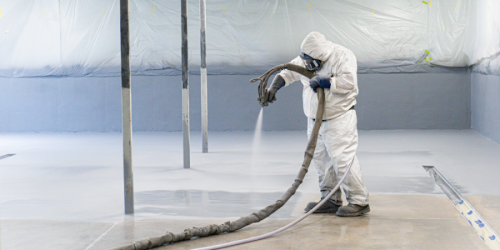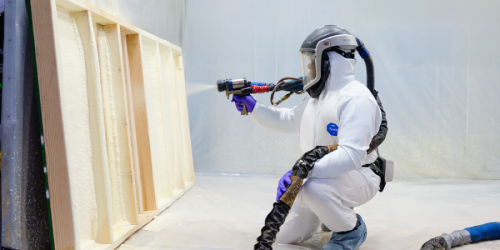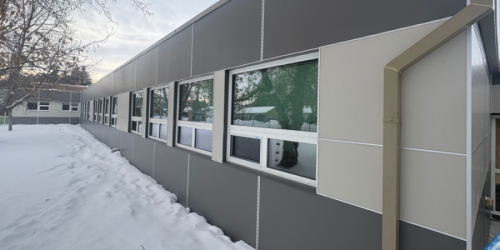Q&A Forums
CC spray foam in vented attic application Post New Topic | Post Reply
| Author | Comments |
|---|---|
|
Kelly Lentz
Posted: Jun 18, 2008 08:23 AM
|
CC spray foam in vented attic application
My location is South Central Pennsylvania (17241) I will soon be insulating the attic area of my one story 3300 square foot ICF residence with full basement. Upon submitting my plans for analysis to Energy Wise Structures- McKinney, TX I outlined that I planned to place one inch of closed cell spray foam on the attic floor to complete the envelope and then add R-50 blown cellulose over top to increase the R-value, while letting the attic breathe from soffitt to ridge vent. Energy Wise Structures provided no negative feedback on this approach so I assumed this to be acceptable for my application and geographic location. From the literature I have read most ventless attic systems are using 3 inches of CC spray foam or 6 inches of OC spray foam to compete the envelope in the attic area with no other insulation needed. I plan to use a closed cell product and apply it directly to the attic floor on the back side of the drywall and between the bottom truss cord. My reasoning for this is as follows: I have very steep pitched roofs that would be difficult to access. My total square foot area under the shingles equals 6400 square feet. The “floor area” of the attic equals 4550 square feet. This is almost a 2000 square foot difference (Less square footage = less product and time which = less money.) There is no HVAC, Plumbing or other equipment in the attic area. It is for this reason that I have chosen not to encapsulate the entire attic area (under the shingle area) and only spray the attic floor area. The soffitt and ridge vents will be utilized so the attic area will “breathe”. I have radiant barrier on the backside of the plywood sheathing covering the roof. I have a Heat Recovery Ventilator planned for installation. My bottom truss cords are 2 X 6 construction. My question(s) are: 1. If using only closed cell (CC) spray foam in the attic floor area how many inches of product is required to provide me with a complete seal (no air infiltration) and at the same time guard against conduction, convection, radiation, moisture permeation and provide an acceptable R-value for my geographical area? 2. Is there any reason I can not place 4 inches of Dow Foamular polystyrene (R-5 per inch)(closed cell product)between each bottom truss cord and then spray one inch of CC spray foam on top of the foam-board? I know the placing of the foam board will be time consuming, but my time is “free” and this method would be clearly more cost effective. Thank you for time and assistance, Newville, PA 17241 |
|
mason
Posted: Jun 18, 2008 09:03 AM
|
Lotsa of questions requiring some basic background info. Installing ccSPF to the floor of the attic will airseal the attic from your living space while providing an R value of around 6 per inch. The cellulose insulation installed to the top of the foam will provide an additional R 50. The cellulose will still allow convective currents in the attic, though with one inch of SPF not as pronounced as if you did not have it. Why so much cellulose? R 50 is overkill in a mixed climate such as Pennsyvania. I have an attic similarly constructed in Northern Virginia with 3 inches of ccSPF to the floor and 1-1/2 inches of UreK cellulose insulation on top just to provide an ignition barrier. I do agree that if you do not have any ductwork or HVAC equipment in the attic that you will not get a significant energy penalty for spraying to the floor of the attic rather than to the underside of the roof deck. 3-4 inches of ccSPF will effectively separate the interior space from the exterior environment. In essence your attic becomes exterior space. So your attic temperatures and humidity would be similar to the outside environment. Placing the Dow board would be time consuming and leave an air gap where condensation is more likely to occur, so I would advise against it. 3-4 inches of ccSPF is sufficient insulation, more than that is not cost effective for the insulation value, but I can't imagine that R 50 of cellulose is less expensive than 2 more inches of closed cell foam. (Any help out there would be appreciated. Check with your building official before going forward with your design. They may require R 38 in your attic, unless you provide them with research data demonstrating that lessor R values amounts would provide greater energy efficiency. (available from SPFA at sprayfoam.org) I assume you are spraying over the wood floor framing. This will provide continuous air barrier and insulation for much greater insulation efficiency. Remember attics and crawl spaces require ignition barriers and certain cellulose products such as Ure K can provide that. (also 1-1/2 inches of any mineral fiber including fiberglass and mineral wool) |
|
Kelly Lentz
Posted: Jun 18, 2008 09:50 AM
|
Thank you for your responses. Sorry about the book. I will try and keep my reply short and to the point. 1. You asked if I would be spraying over the wood floor framing. I will be spraying from the attic side down onto the drywall and between the bottom truss cord. My bottom truss cord is 2"X 6" material so the CC spray material will not fill all of the bottom truss cord. 2. I have to agree on your comments on using the polystyrene sheets, let alone the fact it will be a huge pain in the butt to install. My plan was to: Using 2"X 4'X 8' sheets cut down with a table saw to tightly fit between the bottom truss cord. I would then spray 2 inches of spray foam onto the foam board from the attic side. The 2 inches of spray foam on the attic side would take care of any air infiltration or condensation. Or I could simply go with 3 sets providing 3 inches of CC material at approx. the same cost with out the hassle of installing the board. I was just looking at getting the most for my money. 4500 square feet of attic area to cover 2 inches of spray foam = $5500.00 installed 2 inches of foam board = $2700.00 Self installed) .....So 2" of foam with 2" of cc spray foam=$8200.00 yielding R-22-R-24 or ...... 3" of cc spray foam =$8250.00 yielding R-18 to R-21 Again your opinion and thoughts are greatly valued and appreciated. Kelly Lentz Newville, PA |
|
Bryan Kwater
Posted: Jun 18, 2008 01:17 PM
|
4500 sf of 2" for $5500 is $1.22 per sf. Way cheaper than we will spray for. Our material cost alone is around 1.10 for 2" after the current increases. Plus you will need 2 full sets. Someone must need work REAL BAD. |
|
mason
Posted: Jun 19, 2008 07:23 AM
|
My bottom truss is also a 2"x6". The way to spray it is to spray from a distance covering the truss along with drywall with a uniform layer of foam. It works great, continuous insulation, air barrier and adds structural strength to the floor so that you are less likely to fall through. |
|
Kelly Lentz
Posted: Jun 19, 2008 10:42 AM
|
Thanks for the information. I will be sure to cover the truss as you suggested. As you indicated earlier I checked with my building inspector and the requirements for my area are R-38 in attic areas and R-30 for cathedral areas. He mentioned he had just encountered his first CC spray foam attic installation and he required them to have 6 inches of foam so as to satisfy the R-38 requirement. I asked him if I can provide him with data, studies, or anecdotal evidence that demonstrates that 4 inches of spray foam will perform or exceed cellulose or fiberglass installed at R-38 would he accept that. He indicated he absolutely would. After hanging up with the building inspector I realized it would be easier to demonstrate with charts and graphs I already have that show the minimal impact off adding increased amounts of cc Spray foam above 3 inches-(You eluded to this earlier I just was not catching on) In checking out the sprayfoam.org website as you suggested I could not find any information in this area. I have an E-mail into them requesting information. I found a CC spray foam with an R-value of 6.9 that has a cementious base and therefore I will not need an ignition barrier on the attic side. Some slight issues spraying overhead with this formulation, but most of my application will be spraying downward. Thanks again. |
|
richard sucher II
Posted: Jun 19, 2008 04:00 PM
|
Cementitious based closed cell foam system - what is name of product? Is there an ICC report on this product? Would like to learn more about this material. Thanks. |
|
mason
Posted: Jun 20, 2008 07:20 AM
|
Ask SPFA for the ORNL attic performance testing and ATI wall performance test reports. Both of these demonstrate that sprayfoam performs 15% to 45% better than fiberglass insulation in wall and ceiling assemblies. If they can't find it, email me at masonknowles@aol.com and I will forward the reports. I know of no sprayfoam that has a cementitious base and does not require an ignition barrier in attics. I would not install any foam plastic without an ignition barrier in an attic or crawl space. There have been tragic fires in attics that could have been mitigated with an ignition or thermal barrier. Ask for the manufacturer's ICC Evaluation Report currently dated on the product and the specific application before using any foam so that you can know if it has been tested, evaluated and approved by the ICC building codes for this specific use. |
|
Kelly Lentz
Posted: Jun 24, 2008 09:02 AM
|
I requested SPFA send me the ORNL attic performance testing and ATI wall performance test reports that you mentioned. I haven't received anything as of today, but its been less than a week so I will be patient. You are correct on the sprayfoam not being cementitious. I was mis-informed. The CC product being offered "allegedly" has additives that provides it with the 15 minute ignition barrior rating. As soon as I have a product name and the manufacturer's ICC Evaluation Report I will provide that information. I am committed to using 3 inches of spray foam in the attic area to complete my ICF project, but I now see why spray foam can be a tough sell to the residential market: Putting all of the Building Science aside and the endless great reasons to use spray foam lets look only at some of my numbers: To cellulose my house to an R-60 would cost less than $3000.00. In order to place 3 inches of CC foam the cost I am able to "arrive" at is $10,500.00. ($2000 to $4000 more if you call most foam installers) Add in the Heat Recovery Ventilator at $2500.00 and the total reaches $13,000.00. The difference between using cellulose and sprayfoam becomes $10,000.00. EnergyWise Structures out of Texas who did my energy analysis indicated that my ceilings with 1 inch of CC spray foam and R-50 cellulose blown over top would result in the ceiling being responsible for 6.8 percent of my heat loss equating to $62 in heating cost per year. It would account for 7.7 percent of my cooling load equating to $10 per year. So the ceiling component for heating and cooling cost per year equals $72. (Geo-thermal @ 9 cents per KW.) So the question is? Based on the additional heat loss or heat load in the summer from using cellulose only over CC foam and taking into account current and future energy costs how long will it take me to break even on the additional $10,000 invested in using CC foam, at which point I would then start to realize a savings. Even if my heating and cooling cost increase five fold from $72.00 to $360.00 per year for the ceiling component alone, my break even point would occur in 27.7 years. The truth is I don't know what my increase would be? 5 fold, 10 fold, 20 fold, etc if using cellulose only. I am sure EnergyWise Structues could calculate that number for me. I realize I am ignoring an endless number of positive secondary impacts when taking spray foam out of the equation such as overall comfort of the home, HVAC sizing and lifespan, etc, etc, etc. Thanks again. |
|
mason
Posted: Jun 26, 2008 11:56 AM
|
I spent over $5000 re insulating my attic and basement using cc SPF. The difference between blown in fiberglass or cellulose was dramatic. My temperatures on a 85 degree day ranged from 66.5 degrees in the basement, 71.5 on the first floor and 74.5 on the second floor. After taking out the blown in cellulose on the floor of the attic and 6 inches of batt insulation in the basement. I installed 3 inches of ccSPF to the floor of the attic and 1 inch to the walls or the basement. (3 inches to the sill plate). Results: temperature on 85 degree day basement 69 degrees, first floor 71 degrees, second floor 71.5 degrees. After 5 years, average annual energy savings 25%. Was it worth it? Definitely yes. |





























